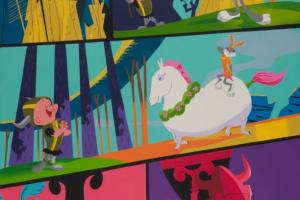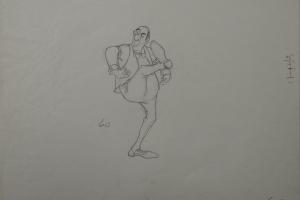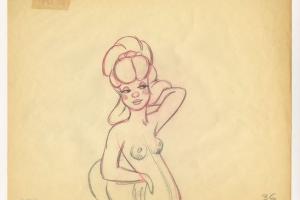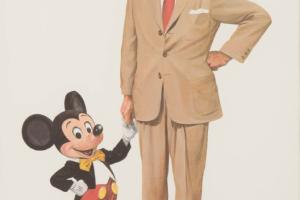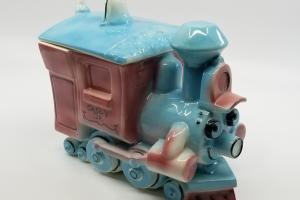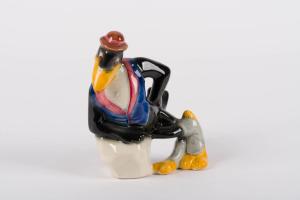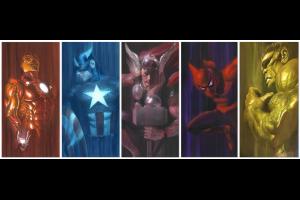Featured Artists
Alan Bodner
Alan Bodner’s fine art is an extension of an Emmy Award-winning, 25-year career as an Art Director for numerous studios and production companies, including the Walt Disney Company, Warner Bros., DreamWorks, The Cartoon Network, and Filmation, to name a few. Credits include the Emmy-nominated Kim Possible, Phineas & Ferb, The Replacements, Mickey’s Twice Upon A Christmas, The Iron Giant, Cinderella II, Neighbors From Hell, The Life & Times of Juniper Lee, Pee Wee's Playhouse, Carrotblanca, and many more. His five Annie Award nominations include a win for Warner Bros. The Iron Giant and an Emmy for Disney’s Tangled Series. He is currently the art director on Disney's Mickey Mouse Funhouse series.
Bodner’s art is a mastery of original painting, digital imagery, and dimensional paper sculpture. The vibrant, theatrical compositions embody a menagerie of original characters, personalities, and monsters in surreal, complex settings. With cultural references to the past, present, and his personal vision of the future, Bodner compounds, distorts, and exaggerates for emotional effect—the result consistently friendly and engaging. A selection of his limited edition prints, as well as a few of his stunning originals will be available through our gallery. Join us in celebrating his artworks and unique vision.
Fred Moore
Fred "Freddie" Moore (September 7, 1911 – November 23, 1952) Fred Moore began his career in animation in 1930 with Walt Disney Studios. In spite of his limited training in animation, his natural talent for character design resulted in his ascension through the ranks of the studio. His talents were so well respected that he redesigned the look of Mickey during the Sorcerer's Apprentice of Fantasia, a look that remains the standard for Mickey to this day. His talents were so well respected that Walt Disney assigned Freddie with the role of directing animator for the dwarfs for Snow White and the Seven Dwarfs. Moore continued to influence the style of characters at the Disney studios with his influence seen in the centaurettes in Fantasia, All the Cats Join In, the mermaid in Peter Pan, the Three Little Pigs, Timothy Mouse in Dumbo, the daughters in Casey Bats Again, the White Rabbit in Alice in Wonderland, and Lampwick in Pinocchio. His reputation for drawing nude and seductive women, including the mural of the studio's penthouse club, has developed into a loyal fanbase for drawings of "Freddie Moore Girls." Moore left the Disney studios for a while in the 1940s and joined Walter Lantz Studios, where he redesigned the studio's main characters, Woody Woodpecker and Andy Panda. Unfortunately, Moore's life and talents were never fully realized as he passed away at the age of 41 after being struck by an oncoming vehicle in a car accident. He was posthumously named a Disney Legend in 1995, and continues to be regarded as an influential part of animation history.
Bob Singer
Bob Singer was born in Santa Barbara, California and spent his early years in nearby Santa Paula, California. He attended the Art Center School in Los Angeles, majoring in advertising illustration and graduating in 1954 with honors and BPA degree.
After a year with Carson/Roberts advertising agency, Bob entered the animation industry in 1956, working for such studios as Shamus Culhane, Warner Bros., U.P.A. Pictures, Hanna-Barbera, and Marvel. During his career at Warner’s, he painted backgrounds for various Bugs Bunny and Daffy Duck cartoons and completed storyboards for a series of four hour-long science-oriented films. At U.P.A. Pictures Bob worked on numerous Mr. Magoo TV shows and was art director on the feature-length film “Gay Purree.” Over at Hanna-Barbera, where he spent twenty-seven years, Bob served as layout supervisor on “Charlotte’s Web” and on many of the studio’s television shows, including “Scooby Doo,” “Space Ghost,” “Superfriends,” “Josie and the Pussycats,” and Wacky Racers.” He founded the Character Design Dept. and eventually became art director of publicity and advertising.
During this period Bob began to teach classes in Layout, Character Design, and Storyboard and was a guest lecturer at U.S.C. and several local high school and elementary schools.
After leaving Hanna-Barbera in 1966 Bob worked for Marvel Productions and Sepp/Inter, where he acted as associate producer on the ‘Snorks.” In 1988 Bob established his own company, Singer/Bandy Group and for the next two years designed greeting cards, cassette covers, coloring books , plush dolls, picture puzzles and illustrated nine storybooks.
In 1990, he returned to Hanna- Barbera as a storyboard director and designer of animation cel art, finally retiring in 1993. For several years Bob did guest appearances at various Warner Bros. Stores around the world, U.S., Hawaii and Australia lecturing and demonstrating his storyboard technique and helping to sell limited editions that he designed, now numbering over 30.
Bob has been a member of the Motion Picture Academy since 1964. In 1992 he wrote a book called “How To Do Animation Storyboards.” He continues designing occasionally for the industry and lecturing for art schools.
Charles Boyer
Charles Boyer is a Disney Legend who initially accepted a job at Disneyland in 1960 with the anticipation of the job being temporary. Boyer's career with the company lasted for 39 years, with Charles becoming the first full-time artist for Disneyland. During this time, he created nearly 50 different lithographs for collectors and a plethora of other artwork that was used for magazines, brochures, flyers, and oil portraits commissioned by the company for retiring employees. Charles Boyer retired in 1999 and was honored as a Disney Legend in 2005.
Alex Ross
Born in Portland, Oregon, and raised in Lubbock, Texas, Alex made his artistic debut at three when, according to his mother, he grabbed a piece of paper and drew the contents of a television commercial he'd seen moments before. By age 13 he was scripting and drawing original comic books. Ten years later? He was hired by Marvel Comics to illustrate Marvel's central characters in the comic book event, Marvels (1994).
Having established himself creatively and financially with superhero projects, Ross turned to the real world with Uncle Sam, a 96-page story that took a hard look at the dark side of American history. Like Marvels, the individual issues of Uncle Sam were collected into a single volume - first in hardcover, then in paperback - and remain in print today. Ross would eventually go on to win the Comic Buyer's Guide Award for Favorite Painter. He won so many times that the award was officially retired.
Alex's work has celebrated the 60th anniversaries of Superman, Batman, Captain Marvel and Wonder Woman with fully painted, tabloid-sized books, depicting each of these characters using their powers to inspire humanity as well as help them.
In recent years, Ross has applied his artistic skills to outside projects with comic book roots, including a limited-edition promotional poster for the Academy Awards. In 2015, Alex was chosen by Apple Corps LTD to be commissioned as the first artist in over 30 years to paint the Fab Four. Driven by the Beatles legendary music and inspired by the generation's new trends in art, "Yellow Submarine" is a classic of animated cinema. Alex has often been referred to as 'the Norman Rockwell of comics' yet his "Yellow Submarine" piece reveals the similarly powerful influence of master surrealist Salvador Dali, whom Alex has also recognized as a guiding influence on his style.
Forty years ago, Spider-Man learned that with great power comes great responsibility. Looking at Alex Ross, it's obvious the lesson took.
Looking back, it makes perfect sense that Alex Ross would become one of the world's most preeminent and well-respected comic book artists. It's a job he's been preparing for nearly all his life.
